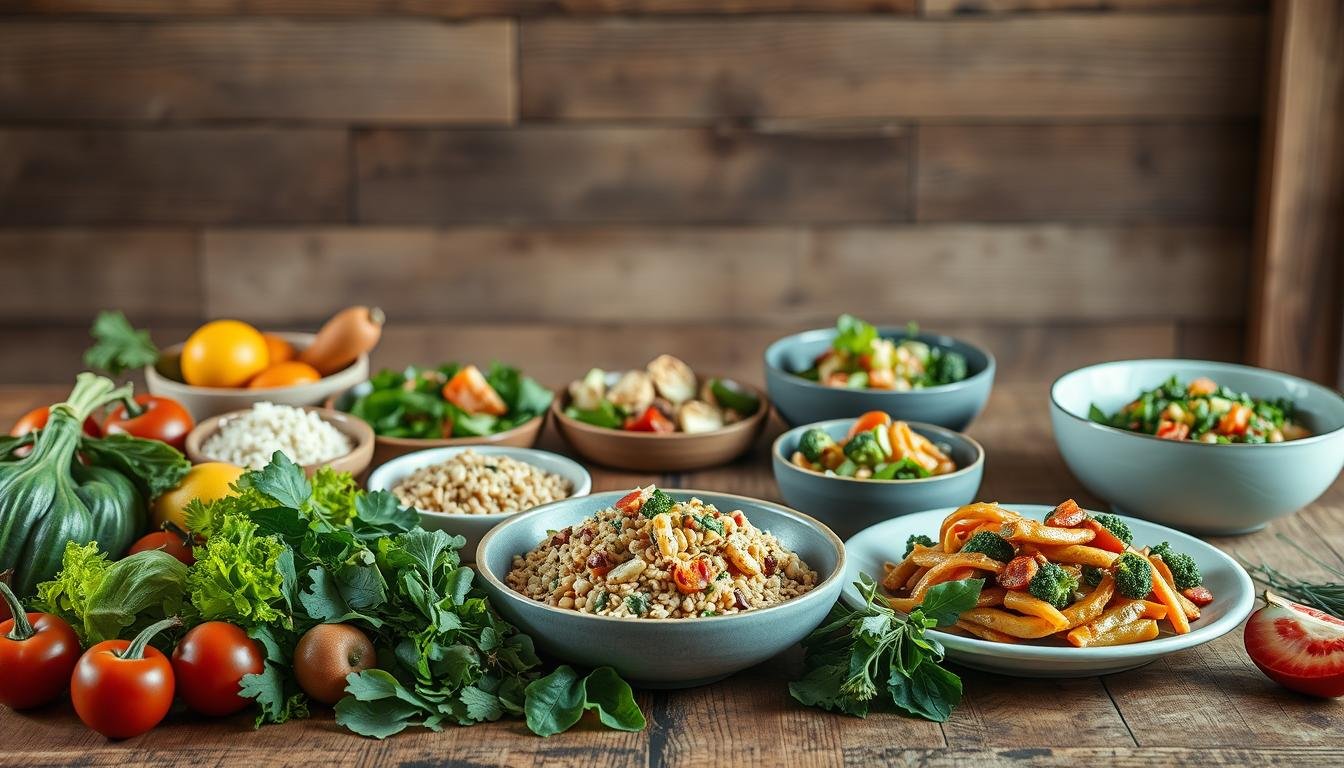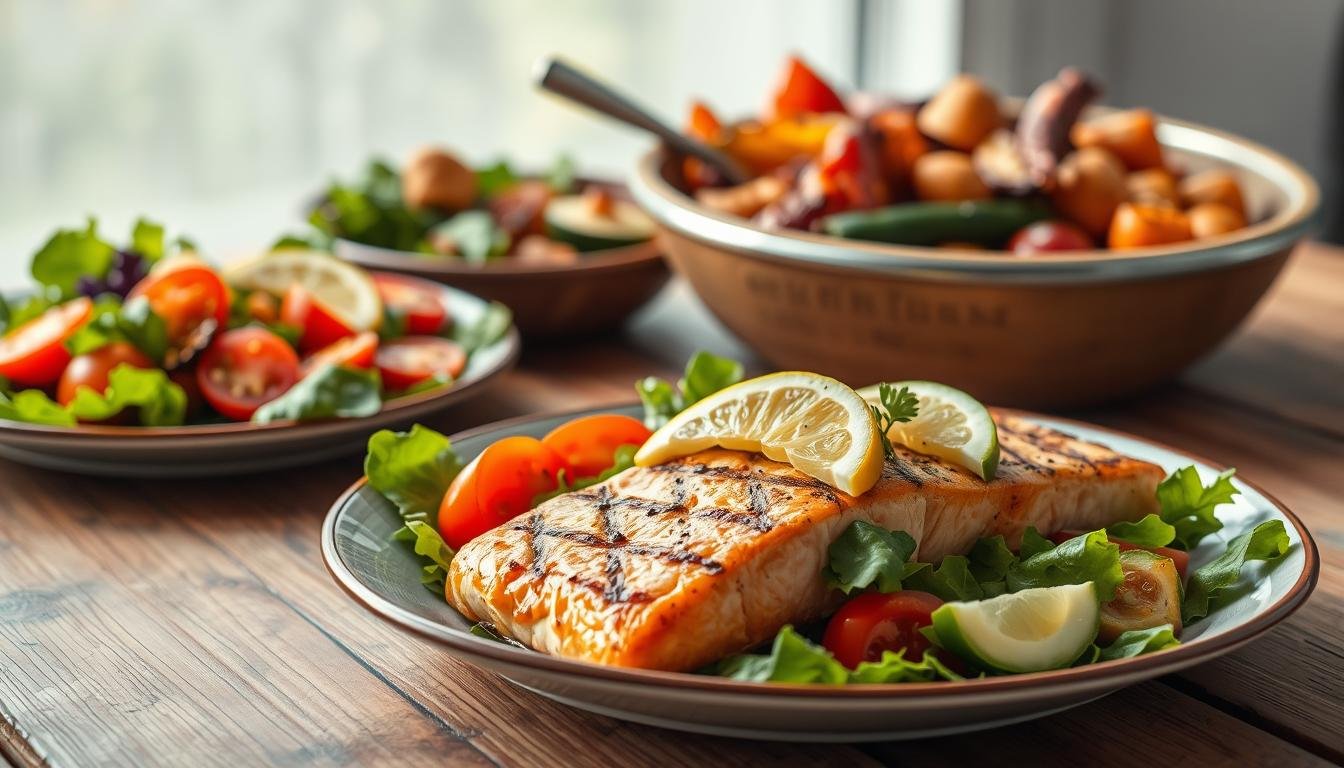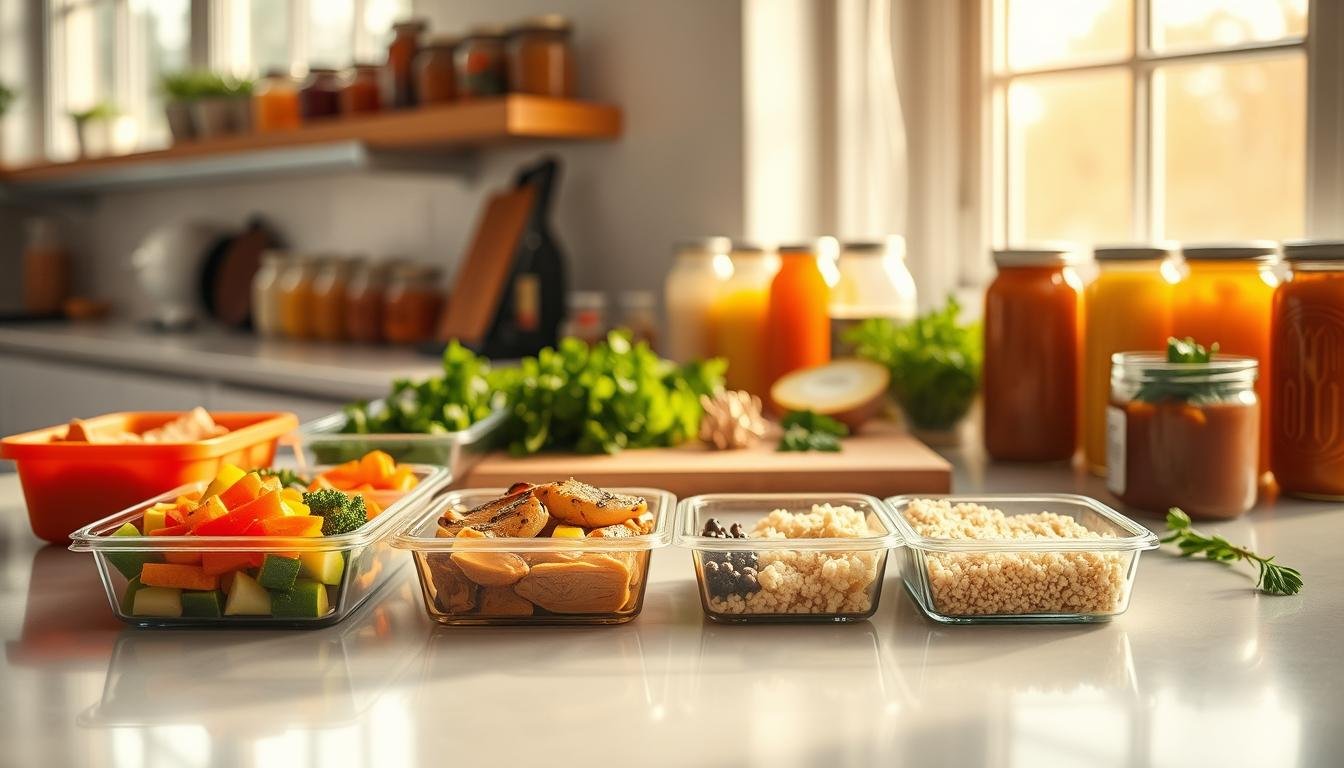Did you ever think gluten-free meals couldn’t rival traditional dishes? Think again. Today, gluten-free options are more than just a medical need. They’re a vibrant, flavorful lifestyle choice. From hearty breakfasts to rich desserts, this guide shows how gluten-free food can be both satisfying and diverse.
This article breaks down how gluten-free eating offers endless possibilities. Learn to replace everyday ingredients without sacrificing taste. Discover smart grocery picks and explore recipes that prove gluten-free food is anything but bland. Whether you’re new to the lifestyle or a seasoned pro, these tips will transform your kitchen routine.
Key Takeaways
- Gluten-free options now match the variety and flavor of traditional meals.
- Modern recipes use creative substitutes like almond flour and quinoa.
- Discover practical tips for navigating grocery stores and restaurants.
- Gluten-free food can boost nutrition while keeping dishes satisfying.
- Explore step-by-step guides for baking, cooking, and snacking.
Understanding Gluten-Free Options
Choosing gluten-free options means knowing what to avoid. Gluten is a protein found in wheat, barley, and rye. It must be absent in products labeled gluten-free. The FDA sets a limit of less than 20 parts per million of gluten for these products.
What Does Gluten-Free Mean?
Gluten-free certification means foods meet strict standards. Look for labels from groups like the Gluten-Free Certification Organization (GFCO) to ensure safety. Always check ingredients, as factories can sometimes mix gluten-free and gluten products.
Common Sources of Gluten
- Processed foods: Sauces, soups, and dressings often contain hidden gluten.
- Alcoholic drinks: Beer and malt-based beverages may have barley.
- Prepackaged snacks: Baked goods, cereals, and seasoned chips commonly include wheat flour.
Why Choose Gluten-Free?
- Celiac disease: A medical necessity to avoid severe health issues.
- Sensitivity: Many report reduced bloating or fatigue with the best gluten-free options.
- Allergies: Wheat allergies require strict avoidance of cross-contact.
- Wellness: Exploring these choices can expand dietary variety for all eaters.
Understanding these basics helps you confidently choose gluten-free options. Whether you’re dining out or shopping for groceries, you’ll be better prepared.
Benefits of a Gluten-Free Diet
Switching to a gluten-free diet can bring many health benefits. You might notice better digestion and more energy. Choosing gluten-free choices can lead to a healthier lifestyle. It also opens up a world of nutritious foods that fit today’s dietary needs.
Improved Digestion
One big plus is less stomach trouble. Cutting out gluten can reduce bloating, gas, and irregular bowel movements. Many people see their digestion improve within a few weeks of avoiding gluten in their diet.
Increased Energy Levels
Feeling tired from gluten can go away as you get used to eating without it. Without gluten, some people feel more alert and focused all day. This shows how choosing gluten-free choices can boost your energy and overall health.
Enhanced Nutritional Choices
Looking into top gluten-free options can make your diet more varied and nutritious. You’ll start eating foods like quinoa, amaranth, and teff, which are full of fiber and minerals. This change can lead to more protein and less processed carbs, helping you eat better.
Delicious Gluten-Free Breakfast Ideas
Starting your day with a gluten-free breakfast doesn’t mean you have to give up flavor. These recipes are perfect for any gluten-free menu. They offer vibrant options that are both tasty and nutritious. From creamy porridges to fluffy pancakes, these dishes will energize your mornings without gluten.
Smoothie Bowls
Blend frozen mango, spinach, and almond milk until smooth. Pour it into a bowl and top with gluten-free granola, shredded coconut, and goji berries. Use Nature’s Path gluten-free granola for this dish. Add protein powder for extra energy.
Quinoa Porridge
Cook quinoa with almond milk until it’s thick. Add vanilla extract and cinnamon for flavor. Top it with sliced bananas or a dollop of peanut butter. This porridge has 8g protein per cup, making it a great gluten-free choice.
Gluten-Free Pancakes
Whisk Bob’s Red Mill Gluten-Free 1-to1 Baking Flour with eggs, baking powder, and milk. Cook into pancakes and serve with maple syrup. Add blueberries or chocolate chips for extra sweetness and texture.
| Meal | Protein per Serving | Prep Time | Key Ingredient |
|---|---|---|---|
| Smoothie Bowls | 15g | 8-10 mins | Almond milk |
| Quinoa Porridge | 22g | 15 mins | Quinoa |
| Pancakes | 6g | 20 mins | Gluten-free flour |
Savory Gluten-Free Lunch Options
Creating a satisfying gluten-free lunch is all about using fresh ingredients and making smart swaps. These ideas transform midday meals into tasty breaks from the usual. They show that gluten-free dining can be both healthy and delicious.
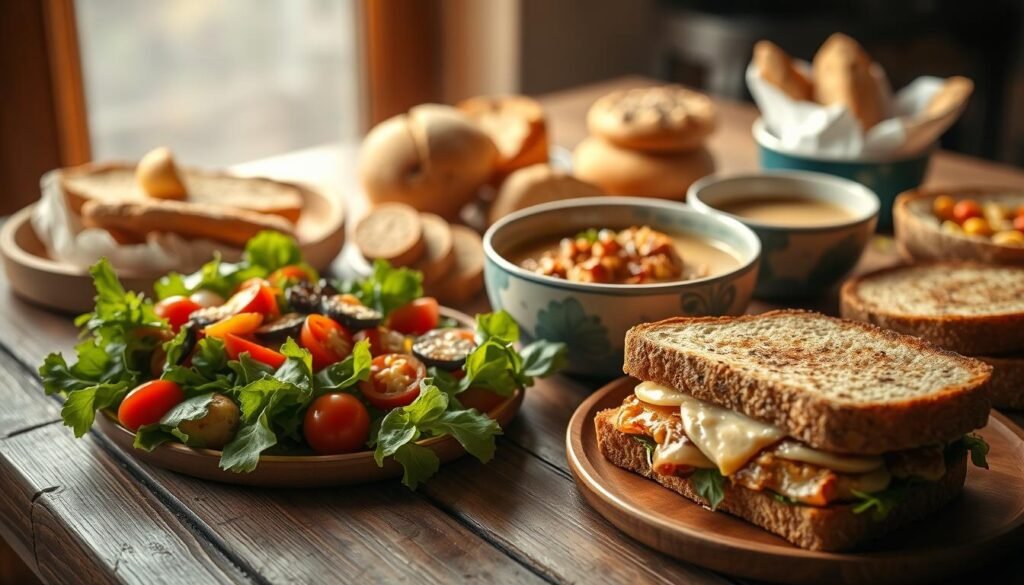
“A well-planned lunch boosts focus and energy—without gluten, creativity is the secret ingredient.” — Academy of Nutrition and Dietetics
Fresh Salad Combinations
Salads are more than just greens. Mix in gluten-free food favorites like roasted chickpeas, grilled chicken, or tofu with quinoa, farro, or wild rice. Add a zing with lemon-tahini dressings or balsamic vinaigrettes. Here are some protein-rich ideas:
- Grilled shrimp or salmon
- Crispy tofu strips
- Heirloom tomatoes with feta
- Edamame or black beans
Gluten-Free Wraps
Trade in regular tortillas for brands like Mission Corn Tortillas or Siete almond flour wraps. Fill them with turkey, avocado, and spinach for a meal you can hold. For a plant-based choice, layer roasted veggies with hummus—no crumbs, just taste.
Hearty Soups
Warm up with broths thickened by potato starch or lentils. Try these:
- Vegetable barley soup
- Chicken noodle made with Beanfields gluten-free noodles
- Tomato basil with spinach
Pair with gluten-free crackers for a full meal.
Tasty Gluten-Free Dinner Recipes
Enjoy hearty, flavorful meals that prove gluten-free doesn’t mean sacrificing taste. These gluten-free dishes are perfect for home cooking or dining at a gluten-free restaurant. Each recipe balances nutrition and creativity for satisfying evening meals.
| Recipe | Key Ingredients | Prep Time |
|---|---|---|
| Zucchini Noodles with Pesto | Zucchini, basil, pine nuts, olive oil | 25 minutes |
| Grilled Chicken with Quinoa | Chicken breast, quinoa, garlic, vegetables | 30 minutes |
| Stuffed Bell Peppers | Bell peppers, rice, black beans, corn | 40 minutes |
Zucchini Noodles with Pesto
Spiralized zucchini replaces pasta in this light dish. Blend fresh basil, garlic, and pine nuts for pesto. Add cherry tomatoes and avocado for extra flavor. Serve chilled or at room temperature.
- Ingredients: 2 zucchinis, ½ cup basil, ¼ cup pine nuts
- Tip: Use a spiralizer for thin, noodle-like strands
Grilled Chicken with Quinoa
Marinate chicken in olive oil and herbs before grilling. Cook quinoa with broth for fluffy grains. Add roasted asparagus or spinach for texture. This dish mirrors meals at upscale gluten-free restaurants.
- Protein: Chicken breast or tofu for vegetarian options
- Serving size: 4 portions
Stuffed Bell Peppers
Hollow bell peppers filled with rice, black beans, and corn. Bake until tender. Top with salsa or cheese. A complete meal in one dish, adaptable to dietary preferences.
- Variations: Add jalapenos for heat or quinoa instead of rice
- Serve with a side salad for balance
Decadent Gluten-Free Snacks
Staying fueled between meals doesn’t mean you have to give up. With smart gluten-free choices, every snack can be both tasty and safe. These three recipes are easy ways to stock up on gluten-free options for any lifestyle.
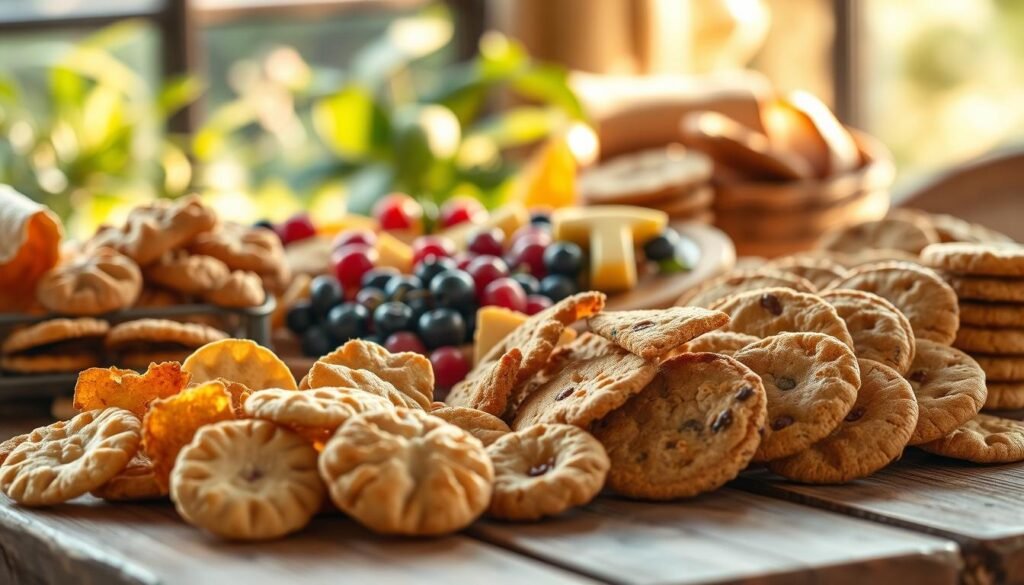
Nut Butter Energy Bites
Mix almond butter, gluten-free oats, chia seeds, and honey. Roll them into bite-sized balls for a quick energy boost. Keep them in an airtight container for up to a week.
Popcorn with Seasoning
Air-popped popcorn seasoned with Himalayan salt, garlic powder, and nutritional yeast is safe. Choose brands like Once Again or Simply Organic to avoid hidden gluten.
Vegetable Chips
Make homemade beet or sweet potato chips at 200°F until crispy. Pair them with store-bought kale chips from Thrive Market. Slice thinly and air-dry overnight for extra crunch.
| Snack Type | Key Ingredients | Nutritional Benefits | Storage Tips |
|---|---|---|---|
| Nut Butter Energy Bites | Almond butter, gluten-free oats | High protein, fiber | Refrigerate 1 week |
| Popcorn | Air-popped, herbs | Low calorie, fiber-rich | Room temp airtight jar |
| Vegetable Chips | Beets, sweet potatoes | Vitamins, low carbs | Freeze for 2 months |
Batch prep means you always have snacks ready. Always check labels to avoid cross-contamination. Choose certified gluten-free brands for store-bought snacks.
Sweet Gluten-Free Desserts
Enjoy sweet treats without gluten with these creative recipes. From velvety cakes to refreshing sorbets, the best gluten-free options show how flavor and texture can thrive without wheat. These desserts use pantry staples and natural ingredients, making sure everyone can enjoy dessert without restrictions.
Flourless Chocolate Cake
This cake is made with eggs, dark chocolate, and a bit of sugar. Its richness comes from pure cocoa. For an extra treat, add espresso powder to deepen the chocolate taste. Brands like Ghirardelli offer high-quality cocoa for a professional touch.
Coconut Macaroons
Make chewy cookies by toasting shredded coconut with honey and vanilla. Use maple syrup instead of sugar and add a pinch of salt. Bob’s Red Mill has certified gluten-free coconut flakes for consistent results.
Fruit Sorbets
Frozen fruit blended with citrus juice makes silky sorbets without an ice cream maker. Try mango or raspberry for a refreshing finish. These options are perfect for any gluten-free menu, showing that dietary needs don’t limit dessert creativity.
Gluten-Free Alternatives for Baking
Baking gluten-free food requires creativity and precision. Find the best gluten-free options to make classic recipes into moist, tasty treats without gluten.
Almond and Coconut Flour
Almond flour adds a rich flavor and needs less liquid. Use it 1:1 for wheat flour in cakes. Coconut flour absorbs a lot of liquid—add ¼ cup coconut flour with extra water or milk. Both are great for making muffins or cookies because they have little gluten.
Gluten-Free Baking Mixes
Top gluten-free options include mixes with rice flour, potato starch, and xanthan gum. Pick one based on what you’re baking: cakes need to be tender, breads need to be sturdy. Brands like Bob’s Red Mill and King Arthur have mixes for different recipes.
- Rice flour adds softness
- Potato starch improves rise
- Xanthan gum helps bind ingredients
Tips for Successful Baking
- Substitute carefully: Start with ¼ teaspoon xanthan gum per cup of flour.
- Moisture matters: Add applesauce or yogurt to prevent dryness.
- Adjust temps: Reduce oven heat by 25°F and bake longer for even results.
Mastering these steps turns baking into a science that works every time.
Eating Out: Finding Gluten-Free Options
Finding the right gluten-free dining spots can make eating out easy. Many gluten-free restaurants now have special menus and controls to avoid cross-contamination. It’s a good idea to research places with a good track record to ensure your meals are safe.
Best Restaurants with Gluten-Free Menus
Big names like Carrabba’s Italian Grill, Olive Garden, and PF Chang’s have gluten-free menus. Look for places with trained staff and separate areas for food prep to avoid cross-contact. Here are some top picks:
| Restaurant | Gluten-Free Highlights | Safety Protocols |
|---|---|---|
| Carrabba’s Italian Grill | Customizable pasta dishes with gluten-free noodles | Separate fryers and dedicated prep tools |
| Olive Garden | 20+ items flagged as gluten-free on their menu | Chef training programs for allergy management |
| PF Chang’s | Rice paper rolls and gluten-free soy sauce | Designated gluten-free stations in select locations |
How to Read Menu Labels
- Watch out for terms like “breadcrumbs,” “wheat flour,” or “thickened soups.”
- Ask servers about shared fryers or seasoning blends that may have gluten.
- Request lists of ingredients for sauces and marinades.
Communicating Your Dietary Needs
Be clear when you say: “I need all ingredients prepared on a clean surface to avoid gluten cross-contact.” Make sure the chef confirms any custom requests.
- Tell your needs when you make a reservation.
- Ask if they use dedicated utensils for gluten-free dishes.
- Check that substitutions are made with gluten-free ingredients.
Talking openly about your needs helps ensure safe and tasty meals.
Grocery Shopping for Gluten-Free Foods
Finding gluten-free foods in grocery stores can be tough. But, with the right strategies, it gets easier. Here are some tips to help you stock your kitchen and shop safely.
Essential Pantry Staples
Keep these items on hand to avoid last-minute shopping:
- Certified gluten-free flours: Bob’s Red Mill or King Arthur
- Rice pasta from brands like Barilla or Jovial
- Quinoa, millet, and buckwheat for grain needs
Buying in bulk at places like Costco can save you money on gluten-free items.
Reading Food Labels Carefully
Always check for hidden gluten:
- Look for “gluten-free” certifications from manufacturers
- Check for cross-contact warnings (e.g., “processed in a facility…”)
- Watch for sneaky terms like malt flavoring or hydrolyzed protein
“Never assume—always read labels, even for spices,” says dietitian Dr. Emily Carter.
Discovering New Products
Try these ways to find new gluten-free products:
Visit stores like Whole Foods or Trader Joe’s for affordable options. Online sites like Thrive Market offer gluten-free menus and deals. Subscription services like Sunbasket send gluten-free meal kits. Follow brands like Enjoy Life Foods or Udi’s for reliable choices. Compare prices online and in stores to save money.
Resources for Gluten-Free Living
Finding gluten-free food and dishes is easier with the right tools. Start with trusted websites like Gluten.gov for official guidelines. Also, check out Beyond Celiac for medical insights and community stories.
Blogs like Minimalist Baker offer quick, creative recipes. Gluten-Free on a Budget focuses on cost-effective meal ideas.
Top Cookbooks for Inspiration
For hands-on guidance, try “Gluten-Free 101: Quick & Easy Recipes” by America’s Test Kitchen. Or, pick “The Complete Gluten-Free Cookbook” by America’s Test Kitchen, with 150+ tested dishes. “Gluten-Free Goddess” by Alana Chernila adapts global cuisines, perfect for varied tastes.
Joining a Community
Connect with local groups via Meetup.com or online forums like the Celiac Support Group on Facebook. These communities share tips, product reviews, and emotional support. They help you stay informed and motivated.

